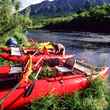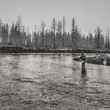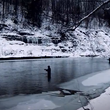You may recall reading something about a proposal from the U.S. Forest Service about commercial filming in wilderness areas on National Forest Service lands. An interim directive had been around for a few years and had garnered little notice. The Forest Service felt it was time to make the directive permanent so they started a rule-making process.
The rule-making caught the attention of many in the public who wrongfully assumed it would apply to them, apply to all public land and that they would have to pay to take pictures and videos on public land. While that was never the case, the organization I run, the Outdoor Writers Association of America, was very concerned because of the potential violation of our First Amendment protections from prior restraint.
In our statement, OWAA President Mark Freeman, outdoors columnist for the Mail Tribune in Medford, Oregon said, “Allowing forest supervisors to decide which journalists get to report in wilderness areas and what stories they can or can't tell smacks of censorship and prior restraint. Restraining journalists and their reports was not intended to be part of the act's restriction of commercialization of wilderness areas."
Not long after that, Larry Chambers, from the U.S. Forest Service Office of Communication, called me to arrange for Freeman and me to speak directly with the U.S. Forest Service Chief Tom Tidwell.
In our conversation with Tidwell we laid out our basic concerns. As representatives of an organization with more than 800 professional outdoor journalists, we saw the directive as an infringement of our First Amendment rights and a direct assault on the ability of freelancers to earn a living. As professional journalists, we see our role as the reporters and storytellers of the outdoor experience. Or as OWAA members put it “the voice of the outdoors.” Our work brings the outdoors to life for the American people every day in newspapers, magazines (like Hatch), books and broadcasts.
The Chief listened carefully to our concerns, especially regarding the First Amendment, agreeing that the directive should not encumber working journalists in the news gathering process and that our members are an important conduit for the public to access the public lands.
Tidwell put his words into action by sending a memo to Forest Service employees clarifying the intent of the directive.
He noted his discussion with the leadership of OWAA and wrote: “News coverage on NFS lands is protected by the Constitution, and it is our responsibility to safeguard that right on the lands we manage for all Americans. Journalists provide a critical public service, and this agency will ensure their access in pursuit of that public service. Journalism is not to be considered a commercial activity for purposes of regulations or our permit policies on any NFS lands. Journalism includes, but is not limited to: breaking news, b-roll, feature news, news documentaries, long-form pieces, background, blogs and any other act that could be considered related to news-gathering.”
This clarification is important and we have encouraged our members to keep it handy.
The Forest Service also held a series of meetings in order to hear from the public, professionals and stakeholder organizations. I went to the meeting in Washington D.C. I voiced our appreciation for the Chief’s clarification and noted our ongoing concern that this directive needed to be consistently applied and not subject to interpretation in the field.
I told them that OWAA members have told us about freelancers and communicators on media staffs receiving different decisions on whether their work in a federally designated wilderness area as well as regular national forest lands requires a permit, despite working on similar assignments.
I also noted a lack of clarity around the whole issue of permitting was having an adverse impact on freelancers who were hearing from clients that permitting was a hassle and they might not want to deal with it.
It was clear from the meeting that the Forest Service leadership wants this rule-making to end peacefully and intends to have the directive reflect the Chief’s memo to the field.
During the meeting, Byron James, the Forest Service’s Acting Director of the Office of Communications, told us they recognized the challenges facing both journalists affiliated with media outlets and freelancers and that the proposed directive had generated a lot of discussion on these types of permits on all NFS lands not just wilderness. They indicated they felt that discussion should continue and were looking at how to do that in the future.
OWAA strongly believes the directive should specifically exempt professional journalists, either working on media staff, working on an assignment for a media outlet or gathering information, images or footage with the intent to publish or air them in a media outlet.
Our recommendations will remove the types of ambiguities OWAA members and others have seen when the current interim rules have been interpreted differently at different times and in different regions.
The work of outdoor journalists that appears in the pages of Hatch and other outdoor media is vitally important. “Journalists provide a critical public service,” wrote Chief Tidwell in his memo.
Outdoor communicator’s inform the public about the health of our natural resources, the status of our wildlife populations and the way public lands are managed. We often sound the alarm when things are not as they should be. Equally important, reading stories and looking at photos of adventures afield are as much a part of this nation’s outdoor heritage as those outdoor activities themselves. Writers, photojournalists, filmmakers and broadcasters bring those adventures to life.
Without them we will lose an important window to the outside world.
OWAA Comments: http://owaa.org/file/usfs-filming-comments-by-owaa-11202014.pdf
Chief Tidwell’s memo: http://owaa.org/file/20141104CommercialFilming&PhotographyPermits.pdf

































Comments
Todd Tanner replied on Permalink
Important info from the OWAA's Tom Sadler. It's good to see that Tom, and the OWAA, are on top of this.
Chris replied on Permalink
Indeed... great work OWAA!
Truchacabra replied on Permalink
Good that someone is watching this. Potential travesty averted.
Al Alborn replied on Permalink
Excellent work! I am certsinly getting full value out of my OWAA membership.
Thanks Tom
Robin Follette replied on Permalink
Thank you for the clarifications and to OWAA for being on top of this issue!
Pages